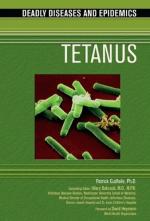|
This section contains 453 words (approx. 2 pages at 300 words per page) |

|
Tetanus is a potentially fatal disease which causes severe contraction of the muscles. Historically called "lockjaw," it usually begins with muscle spasms in the jaw making it difficult to open one's mouth, causes difficulty swallowing, and stiff and painful neck, shoulder, and back muscles which soon spreads to muscles of the abdomen, arms, and legs. (A baby born in unsanitary surroundings can develop neonatal tetanus.) If not treated, the disruption of muscular control may result in fatal interference with breathing. Tetanus is caused by the bacterium called Clostridium tetani, a microorganism which lives in soil, invades the body through breaks in the skin--especially deep puncture wounds--and produces a toxin called tetanospasmin. Although tetanus was widespread at the turn of the century, it can be prevented today through immunization.
Several important scientists made significant contributions to the control of tetanus. Arthur Nicolaier (1862-1942) discovered the tetanus bacterium in 1884. Three...
|
This section contains 453 words (approx. 2 pages at 300 words per page) |

|


